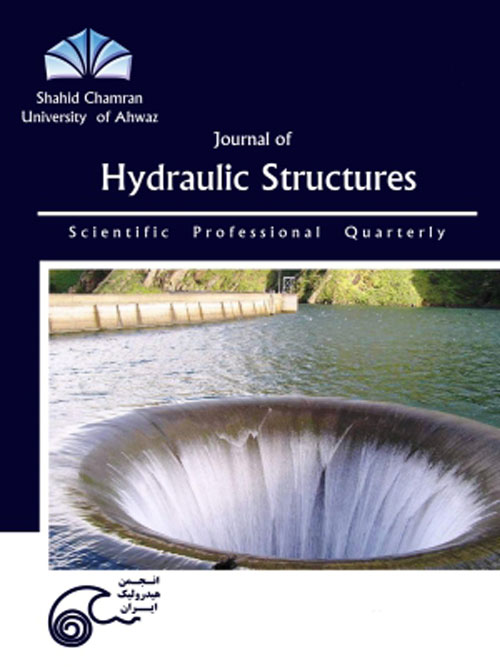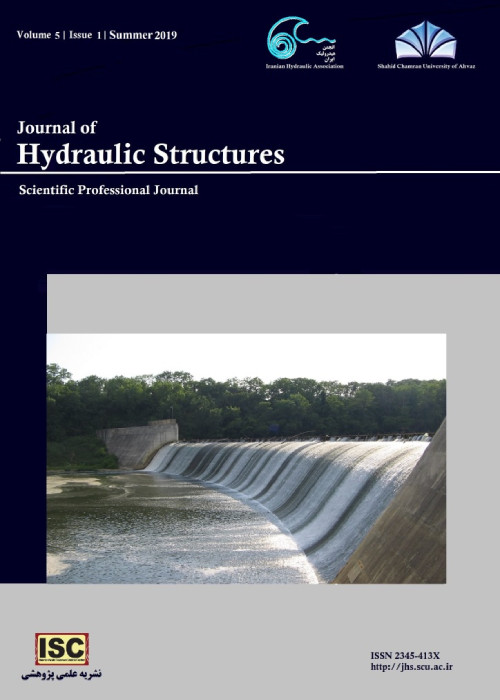فهرست مطالب

Journal of Hydraulic Structures
Volume:1 Issue: 2, Spring 2013
- تاریخ انتشار: 1395/04/15
- تعداد عناوین: 6
-
-
Pages 1-9A novel discrete singular convolution (DSC) formulation is presented for the seepage analysis in irregular geometric porous media. The DSC is a new promising numerical approach which has been recently applied to solve several engineering problems. For a medium with regular geometry, realizing of the DSC for the seepage analysis is straight forward. But DSC implementation for a medium with irregular geometry encounters some challenging issues. To overcome the difficulty, a novel DSC scheme for seepage analysis in irregular geometric porous media is proposed. There is no general analytical solution for the seepage analysis in irregular geometries; thus, the validation of the proposed algorithm is carried out by comparing the results with those from available numerical methods. Good agreement between the results shows that the proposed algorithm can be utilized in solving seepage analysis as a new approach.Keywords: Discrete Singular Convolution, Seepage, Numerical Analysis, Irregular Geometric Medium
-
Pages 10-22Human activities in the recent years have considerably increased the rate of water pollution in many regions of the world. In this case study, the main sources of wastewater discharging into the Gargar River were identified. Using river and point source flow rates and water quality parameters measured along the river, the river water quality was simulated using a commonly used, one-dimensional water quality model, the QUAL2K model. Simulated values of DO, CBOD, NH4-N and NO3-N demonstrated the accuracy of the model and despite a significant data shortage in the study area, QUAL2K model was found to be an acceptable tool for the assessment of water quality. Still, for this case study, it was found that the model was most sensitive to river and point source flows and moderate to fast CBOD oxidation, and nitrification rates.Keywords: Water quality, QUAL2K, Modeling, Wastewater Discharge, Whole, System Water Management
-
Pages 23-32core occur whenever the submergence of the intake is less than a critical value. Anti-vortex devices and specially plates are used to avoid the negative effects of the air-core vortices. If plates are used, then the geometry of them should be studied experimentally. Accordingly, a precise set of experiments have been carried out using rectangular plates with different dimensions. The results showed that using the vertical plates can increase the critical submergence for the same discharge rates to 51%.Keywords: Vertical Intake, Anti, Vortex Device, Submergence of Intake, Air, Core Vortices, Discharge Rate
-
Pages 33-43Measuring sensitivity of hydraulic structures is considered as an approach for evaluation of water projects performance, due to lower distribution efficiency in Irrigation and Drainage project schemes. Sensitivity analysis approach for irrigation structures is one of flow analysis methods which are developed in recent years in order to measure the behavior of flow in hydraulic structures in an irrigation network. This study examines the sensitivity of offtake structures in Varamin irrigation and drainage network project, which is one of the modern networks in Iran. The sensitivity measurement was carried out by the use of collected data from field in years of 2010, 2011 and 2012, and compared them with the water requirement for crop pattern calculated by CROPWAT model. Flow channel simulation was conducted in the project to identify the most sensitive offtake structures, due to inappropriate allocation of water particularly in downstream of network. Simulation and evaluation were carried out using SOBEK hydrodynamic model, and relationships introduced for sensitivity measures for offtake structures. Investigations and sensitive analysis on hydraulics structures in Varamin Irrigation network showed that Baffle modules have significant sensitivity. According to reviewed equations, sensitivity of Baffle modules is related to upstream depth, and opening of NEYRPIC module gates; which occurred more in terminal structures. The best way to have an optimal operation in this network is supply of required water depth in downstream of each canal. In these circumstances, the water depth in all offtakes is provided, and does not make any changes in the opening modules also.Keywords: Sensitivity analysis, Hydrodynamic Modeling, Turnout, Operation, Flow simulation
-
Pages 44-52Accurate prediction of pollution control and environmental protection need a good understanding of pollutant dynamics. Numerical model techniques are important apparatus in this research area. So a 2500 line FORTRAN 95 version code was conducted in which using approximate Riemann solver, couples the shallow water and pollution transport agents in two dimensions by the aid of unstructured meshes. A multidimensional linear reconstruction technique and multidimensional slope limiter were implemented to achieve a second-order spatial accuracy. The courant number ruled as a control parameter for stability conditions and a third order Runge-Kutta method was performed for equation discretizations. For Code verifications another author's case study was examined.
The numerical results show that the model could accurately predict the flow dynamics and pollutant transport in Ajichai River.Keywords: FORTRAN Program, Courant Number, Pollution, Finite Volume, Ajichai River -
Pages 53-66Hydraulic jump on adverse stilling basin is an unstable phenomenon which causes some complexities in controlling of the jump. This paper considers the stability of free hydraulic jump on adverse stilling basins from a theoretical point of view. A minimum value of upstream Froude number is needed to produce the free hydraulic jump on adverse stilling basins which was presented by a theoretical equation. Also, the effects of an end sill and divergence in section on the minimum Froude number were investigated. Moreover, it is required that the bed has a minimum friction for making the jump stable which is obtained as a function of upstream Froude number and bed slope. This condition was compared with the criterion proposed by previous researchers and showed the considerable deviations at larger bed slopes. The result showed that it is impossible to establish the hydraulic jump on concrete adverse stilling basins without any appurtenances. However, diverging in section can improve the stability of hydraulic jump on adverse stilling basins.Keywords: Hydraulic jump, Adverse Basin, Stability, End Sill, Diverging Stilling Basin


